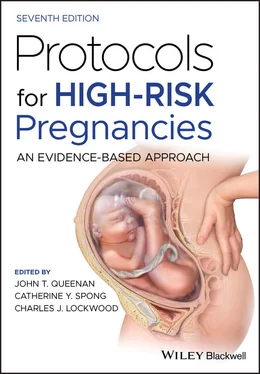19 Society for Maternal‐Fetal Medicine Publications Committee, Berkley E, Chauhan SP, Abuhamad A. Doppler assessment of the fetus with intrauterine growth restriction. Am J Obstet Gynecol 2012; 206(4):300–8.
PROTOCOL 8 Antepartum Testing
Michael P. Nageotte1,2
1Miller Children’s and Women’s Hospital, Long Beach, CA, USA
2Department of Obstetrics and Gynecology, University of California, Irvine, CA, USA
Antepartum fetal testing is utilized to assess fetal well‐being, especially in the complicated pregnancy. Several tests are utilized including the nonstress test (NST), the biophysical profile (BPP), the modified BPP, and the contraction stress test (CST).
The NST is currently the most common means of evaluation of fetal oxygenation status during the antepartum period. Less intensive than the CST in many regards, the NST evolved as an excellent means of fetal assessment following observations that the occurrence of two or more accelerations of the fetal heart during a CST most often predicted a negative CST while the absence of these accelerations of baseline fetal heart rate was associated with a positive test and poor perinatal outcome. The basic premise of the NST is that the fetal heart will accelerate its rate with fetal movement if the fetus is not acidotic or depressed neurologically.
A reactive NST is defined by the presence of two or more accelerations of the fetal heart rate of at least 15 beats per minute lasting for at least 15 seconds within 20 minutes. Other definitions of reactivity have been proposed with a requirement of two or more accelerations in as little as 10 minutes before the test is considered reactive. If such accelerations are not elicited either spontaneously or with repeated vibroacoustic stimulation within 40 minutes of monitoring, the NST is interpreted as nonreactive. Options for further management include admission to hospital for delivery or extended monitoring or, more commonly, some form of backup test (e.g., a CST or BPP) is performed immediately. If the variable decelerations are repetitive or prolonged (lasting greater than one minute), the test is read as equivocal and a back‐up test is indicated at that time.
The NST has a false‐negative rate of approximately 0.3% but this is influenced by indication for test and testing interval. Of note, most nonreactive NSTs have a normal back‐up test, which allows continuation of the pregnancy in most instances. The current recommendation is that the NST should be performed at least twice weekly.
The fetal BPP is a frequently utilized method of antepartum fetal surveillance. The BPP score is a composite of four acute or short‐term variables (fetal tone, movement, breathing, and nonstress test) and one chronic or long‐term variable (amniotic fluid index). All four short‐term variables of the BPP are regulated by the fetal central nervous system (CNS). The fetal CNS is highly sensitive to decreases in the level of oxygenation and these biophysical variables are directly influenced by changes in the state of oxygenation of the fetus.
In the presence of progressive hypoxemia, clinical studies have confirmed that reactivity is the first biophysical variable to disappear. This is followed by the loss of fetal breathing and subsequently the loss of fetal movement. Fetal tone is the last variable to be lost in the presence of ongoing in utero hypoxemia.
Fetal urine production is the predominant source of amniotic fluid volume and is directly dependent upon renal perfusion. In response to sustained fetal hypoxemia, there is a long‐term adaptive response mediated by chemoreceptors located in the aortic arch and carotid arteries. This results in chemoreceptor‐mediated centralization of fetal blood flow by differential channeling of blood to vital organs in the fetus (brain, heart, adrenals), at the expense of nonessential organs (lung, kidney) by means of peripheral vasoconstriction. In cases of prolonged or repetitive episodes of fetal hypoxemia, there is a persistent decrease in blood flow to the lungs and kidneys resulting in a reduction in the amniotic fluid production leading to oligohydramnios. Amniotic fluid volume, therefore, is a reflection of chronic fetal condition. On average, it takes approximately 13 days for a fetus to progress from a normal to an abnormal amniotic fluid volume.
The NST is first performed followed by the sonographic evaluation of fetal biophysical activities including fetal tone, movement, and breathing. Amniotic fluid volume is measured by holding the transducer perpendicular to the floor. The largest vertical pocket is selected in each quadrant. The composite of all four quadrants’ deepest vertical pockets is the amniotic fluid index (AFI). A total of 30 minutes is assigned for obtaining ultrasound variables. A normal variable is assigned a score of 2 and an abnormal variable a score of zero (see Table 8.1).
Table 8.1 Fetal biophysical profile
Source: Based on Manning et al. (1980). Reproduced with permission of Elsevier.
| Biophysical variable |
Normal (score = 2) |
Abnormal (score = 0) |
| Nonstress test |
Reactive: More than two accelerations of greater than 15 bpm for more than 15 seconds in 20 minutes |
Nonreactive: Less than two accelerations of greater than 15 bpm for more than 15 seconds in 20 minutes |
| Fetal breathing movements |
More than one episode of more than 30 seconds in 30 minutes |
Absence or less than 30 seconds in 30 minutes |
| Gross body movements |
More than three discrete body/limb movements in 30 minutes |
Fewer than two discrete body/limb movements in 30 minutes |
| Fetal tone |
More than one active extension/flexion of limb, trunk, or hand |
Slow or absent fetal extension/flexion |
| Amniotic fluid volume |
More than one pocket of fluid greater than 2 cm in two perpendicular planes |
No pocket greater than 1 cm in two perpendicular planes |
A composite score of 8 or 10 is considered normal and correlates with the absence of fetal acidemia. A score of 6 is equivocal, and the test should be repeated in 24 hours, except in cases of oligohydramnios with intact membranes. In this particular instance, either delivery or close fetal surveillance is indicated depending on the gestational age. BPP scores of 4, 2 or 0 indicate fetal compromise and delivery should be strongly considered. The BPP score correlates linearly with fetal pH. A normal BPP score virtually rules out the possibility of fetal acidemia being present at the time of testing. A normal BPP result is highly reassuring, with a stillbirth (false‐negative) rate of 0.8 per 1000 within one week of the test. The positive predictive value of an abnormal BPP for evidence of fetal compromise (concerning fetal heart rate tracing in labor, acidemia, etc.) is approximately 50%, and a negative predictive value of 99.9% with a normal BPP. A BPP score of 6 has a positive predictive value of 25% while a score of 0 correlates with a compromised fetus in close to 100% of cases. Vibroacoustic stimulation (VAS) can be used as an adjunct in the assessment of BPP score without changing the predictive value of the test. Further, this may reduce unnecessary obstetric interventions.
The BPP can either be used as a primary test for fetal well‐being in high‐risk conditions or, more commonly, as a back‐up test for a nonreactive NST.
Modified biophysical profile
Modified BPP is a commonly employed primary mode of fetal surveillance in many institutions. It takes into consideration the two most important predictors of fetal well‐being – fetal heart rate reactivity and amniotic fluid volume. The NST is an excellent predictor of normal fetal oxygenation when reactive. The amniotic fluid assessment is a means to evaluate the chronic uteroplacental function. The NST is performed in the usual manner and interpreted as previously defined. An amniotic fluid index is obtained as in the BPP and a value of greater than 5 is considered to represent a normal amount of amniotic fluid. The combination of the NST and ultrasonographic evaluation of amniotic fluid volume appears to be as reliable as BPP in acutely assessing fetal well‐being, with a very low incidence of false negativity. Indeed, the rate of stillbirth within one week of a normal modified BPP is the same as a normal BPP (0.8 per 1000).
Читать дальше












